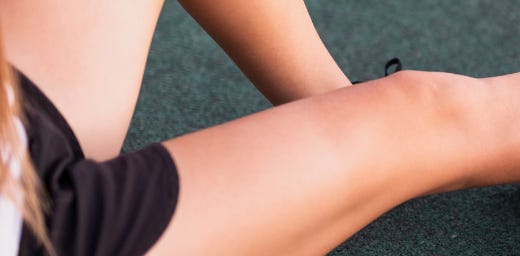Your Fascia Is Smarter Than You Think
The Hidden Tissue That Connects Your Pain, Your Power, and Your Peace
At Vango Wellness, I’m all about building a strong, functional, feel-good body that can carry you through life—not just through workouts. Myofascial release isn’t just for physical therapists or foam-roller fans—it’s one of those “wellness tools” that’s surprisingly foundational once you get to know it.
And funny enough, my introduction came long before my NASM certifications, anatomy textbooks or owning a gym.
✨ It Started With My Grandma
When I was eight, my grandmother showed me something I’ll never forget: she’d lie on the floor, knees bent, gently twist her hips side to side, and breathe. “It loosens everything,” she said. At the time, I didn’t have the language for it—but she was teaching me how to release fascia. She was unwinding her body. Intuitively. Intelligently.
This kind of movement became a core part of how I coach women today—because tight bodies can’t move freely, and freedom is what we’re after.
So… What Is Myofascial Release?
Your fascia is a connective tissue web that wraps around your muscles, organs, and joints. Think of it as your body’s internal support network. When it gets stiff or sticky—from injury, inflammation, stress, or simply life—you feel it: tension, limited mobility, random aches.
Myofascial Release (MFR) is a technique that helps reduce this tension by applying pressure or movement to the fascia to hydrate it, break up adhesions, and reintroduce flow to your body’s system.
🧬 Types of Myofascial Release
There’s no one-size-fits-all. And that’s the beauty of it:
Self-Myofascial Release (SMFR): Using tools like foam rollers, massage balls, or even a rolled-up towel to release tension on your own.
Manual Therapy: Done by a trained physical therapist or bodyworker using hands-on pressure to stretch and loosen fascia.
Active Movement Release: Using bodyweight and slow, intentional movements to target tight areas (like my grandma’s hip twist).
Stretch-Based Release: Mobility and fascia-aware stretches that lengthen tissues and calm the nervous system.
Rebounding (Mini-Trampoline): Light, rhythmic bouncing encourages lymphatic flow and fascial elasticity. It's a playful, low-impact way to release tension and re-energize the body.
Each approach has its place. I often blend these in my client sessions depending on their lifestyle, stress load, and recovery needs.
🔬 Why It Matters (Yes, There’s Science)
Fascia doesn’t just “wrap” your body—it talks to it. It’s full of nerve endings and directly impacts how you move, feel, and recover. Stiff fascia can reduce flexibility, mess with posture, and even contribute to chronic pain.
Research shows myofascial release may help:
✔️ Reduce delayed onset muscle soreness (DOMS)
✔️ Improve joint range of motion
✔️ Decrease stress and cortisol levels
✔️ Support recovery and injury prevention
And yes—hydrated, mobile fascia = a more resilient, pain-free body.
But Why You Should Care About Your Fascia
Fascia is literally the fabric that holds you together. It wraps around every muscle, organ, bone, and nerve—keeping your body both stable and fluid. But most of us don’t think about it until it tightens, restricts, or starts whispering in the form of discomfort, stiffness, or unexplained pain.
🧠 It’s sensory-rich.
Fascia is full of nerve endings. It’s a key player in how you feel pain, sense movement, and even manage stress. It’s not just structure—it’s communication.
🏃♀️ It affects your performance.
Tight fascia can restrict range of motion, cause imbalances, and make recovery slower. When fascia is healthy, your movement becomes more fluid, powerful, and efficient.
🌀 It stores tension.
Yes, emotional stress can live in your tissues—especially fascia. Releasing it isn’t just physical; it can feel like a deep exhale for your whole system.
🔁 It connects everything.
Your fascia links head to toe—so pain in your hip might actually trace back to tension in your feet. Treating fascia helps you look at the whole picture, not just the symptom.
Vango Wellness 5-Minute Myofascial Release Flow
Whether you’re a runner, a desk-sitter, or a mom who just needs to stretch out the tension of the day—you deserve to feel supple, strong, and at ease in your body.
Myofascial release is more than a buzzword. It’s a reset. You don’t need to overhaul your day—just layer it in. Here’s a daily 5-min unwind I often recommend in coaching:
Hip Rolls (OG Grandma move)
Lie on your back, knees bent. Gently rock knees side to side. 60 seconds.Upper Back Roll
Use a foam roller. Slow rolls between shoulder blades. 60 seconds.Calf or Arch Release
Use a ball or can. Roll under feet or calves. 30 seconds each.Chest Opener
Lay on a foam roller vertically (head to tailbone), arms wide. Breathe. 60 seconds.Diaphragmatic Breathing
One hand on chest, one on belly. Inhale low and slow. 5 deep breaths.Rebounding Bounce:
If you happen to have a rebounder, lightly bounce on it (or simulate by gentle heel lifts on the ground) to stimulate fascia and lymph. Remember to protect your back by leaning slightly towards the fronts vs standing straight right up.(5 min)
At Vango Wellness I build systems that support you—starting with the fascia that holds you together.
Let’s me know in the comments if you plan on incorporating it in your daily routine.
Join the Vango Wellness Community!
💌 Subscribe to our newsletter for more wellness tips.
📲 Follow us on Instagram for daily motivation.
🎯 Book a FREE coaching consultation to start your personalized wellness journey.
Your healthiest, most vibrant life starts with the choices you make today!






I really appreciate the focus on practical application. Showing how to fit these exercises into a busy day makes it much more likely that I'll actually do them!